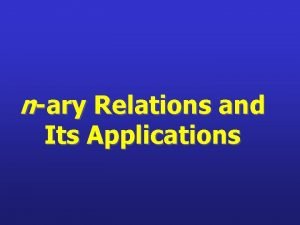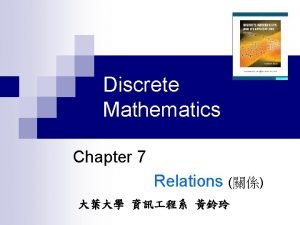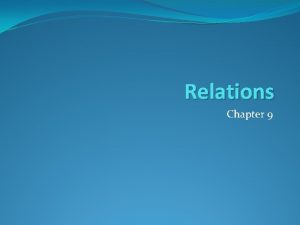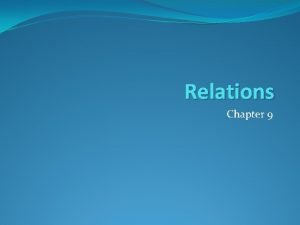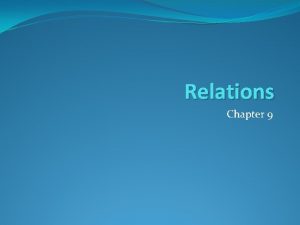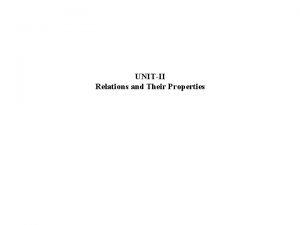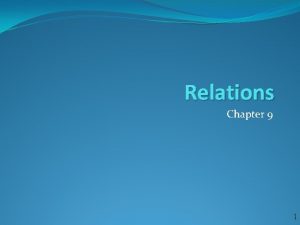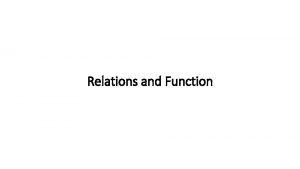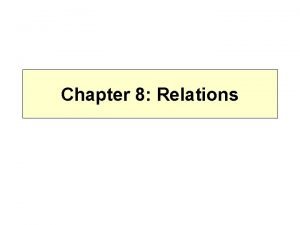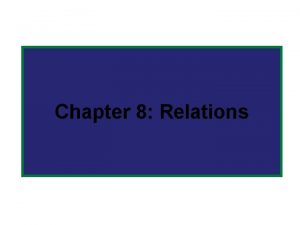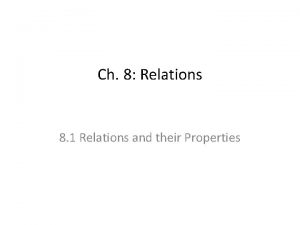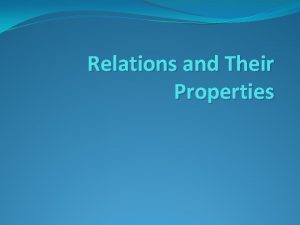Relations Chapter 9 Chapter Summary Relations and Their











- Slides: 11

Relations Chapter 9

Chapter Summary �Relations and Their Properties �n-ary Relations and Their Applications (not currently included in overheads) �Representing Relations �Closures of Relations (not currently included in overheads) �Equivalence Relations �Partial Orderings

Relations and Their Properties Section 9. 1

Section Summary �Relations and Functions �Properties of Relations �Reflexive Relations �Symmetric and Antisymmetric Relations �Transitive Relations �Combining Relations

Binary Relations Definition: A binary relation R from a set A to a set B is a subset R ⊆ A × B. Example: �Let A = {0, 1, 2} and B = {a, b} �{(0, a), (0, b), (1, a) , (2, b)} is a relation from A to B. �We can represent relations from a set A to a set B graphically or using a table: Relations are more general than functions. A function is a relation where exactly one element of B is related to each element of A.

Binary Relation on a Set Definition: A binary relation R on a set A is a subset of A × A or a relation from A to A. Example: �Suppose that A = {a, b, c}. Then R = {(a, a), (a, b), (a, c)} is a relation on A. �Let A = {1, 2, 3, 4}. The ordered pairs in the relation R = {(a, b) | a divides b} are (1, 1), (1, 2), (1, 3), (1, 4), (2, 2), (2, 4), (3, 3), and (4, 4).

Binary Relation on a Set (cont. ) Question: How many relations are there on a set A? Solution: Because a relation on A is the same thing as a subset of A ⨉ A, we count the subsets of A × A. Since A × A has n 2 elements when A has n elements, and a set with m elements has 2 m subsets, there are subsets of A × A. Therefore, there are relations on a set A.

Binary Relations on a Set (cont. ) (SELF STUDY) Example: Consider these relations on the set of integers: R 1 = {(a, b) | a ≤ b}, R 4 = {(a, b) | a = b}, R 2 = {(a, b) | a > b}, R 5 = {(a, b) | a = b + 1}, R 3 = {(a, b) | a = b or a = −b}, R 6 = {(a, b) | a + b ≤ 3}. Note that these relations are on an infinite set and each of these relations is an infinite set. Which of these relations contain each of the pairs (1, 1), (1, 2), (2, 1), (1, − 1), and (2, 2)? Solution: Checking the conditions that define each relation, we see that the pair (1, 1) is in R 1, R 3, R 4 , and R 6: (1, 2) is in R 1 and R 6: (2, 1) is in R 2, R 5, and R 6: (1, − 1) is in R 2, R 3, and R 6 : (2, 2) is in R 1, R 3, and R 4.

Reflexive Relations Definition: R is reflexive iff (a, a) ∊ R for every element a ∊ A. Written symbolically, R is reflexive if and only if ∀x[x∊U ⟶ (x, x) ∊ R] Example: The following relations on the integers are reflexive: If A = ∅ then the empty relation is reflexive vacuously. That is the empty R 1 = {(a, b) | a ≤ b}, relation on an empty set is reflexive! R 3 = {(a, b) | a = b or a = −b}, R 4 = {(a, b) | a = b}. The following relations are not reflexive: R 2 = {(a, b) | a > b} (note that 3 ≯ 3), R 5 = {(a, b) | a = b + 1} (note that 3 ≠ 3 + 1), R 6 = {(a, b) | a + b ≤ 3} (note that 4 + 4 ≰ 3).

Symmetric Relations Definition: R is symmetric iff (b, a) ∊ R whenever (a, b) ∊ R for all a, b ∊ A. Written symbolically, R is symmetric if and only if ∀x∀y [(x, y) ∊R ⟶ (y, x) ∊ R] Example: The following relations on the integers are symmetric: R 3 = {(a, b) | a = b or a = −b}, R 4 = {(a, b) | a = b}, R 6 = {(a, b) | a + b ≤ 3}. The following are not symmetric: R 1 = {(a, b) | a ≤ b} (note that 3 ≤ 4, but 4 ≰ 3), R 2 = {(a, b) | a > b} (note that 4 > 3, but 3 ≯ 4), R 5 = {(a, b) | a = b + 1} (note that 4 = 3 + 1, but 3 ≠ 4 + 1).

Transitive Relations Definition: A relation R on a set A is called transitive if whenever (a, b) ∊ R and (b, c) ∊ R, then (a, c) ∊ R, for all a, b, c ∊ A. Written symbolically, R is transitive if and only if ∀x∀y ∀z[(x, y) ∊R ∧ (y, z) ∊ R ⟶ (x, z) ∊ R ] �Example: The following relations on the integers are transitive: R 1 = {(a, b) | a ≤ b}, For every integer, a ≤ b R 2 = {(a, b) | a > b}, and b ≤ c, then b ≤ c. R 3 = {(a, b) | a = b or a = −b}, R 4 = {(a, b) | a = b}. The following are not transitive: R 5 = {(a, b) | a = b + 1} (note that both (3, 2) and (4, 3) belong to R 5, but not (3, 3)), R 6 = {(a, b) | a + b ≤ 3} (note that both (2, 1) and (1, 2) belong to R 6, but not (2, 2)).
 N-ary relations
N-ary relations Relations and their properties
Relations and their properties Relations and their properties
Relations and their properties Discrete presentation
Discrete presentation Employee relations in public relations
Employee relations in public relations Their eyes were watching god chapter 19-20 summary
Their eyes were watching god chapter 19-20 summary Their eyes were watching god chapter 1
Their eyes were watching god chapter 1 Chapter 7 their eyes were watching god
Chapter 7 their eyes were watching god Their eyes were watching god chapter 10 summary
Their eyes were watching god chapter 10 summary Sparknotes their eyes chapter 6
Sparknotes their eyes chapter 6 Chapter 13 their eyes are watching god
Chapter 13 their eyes are watching god Zora
Zora
